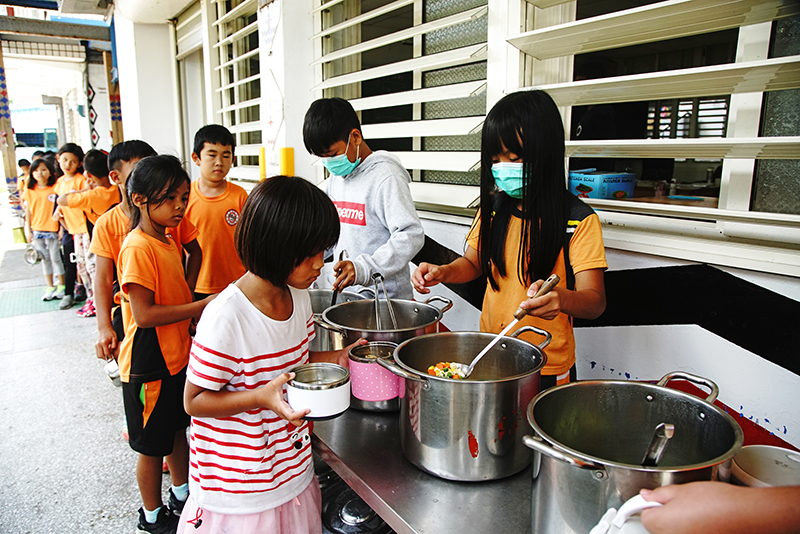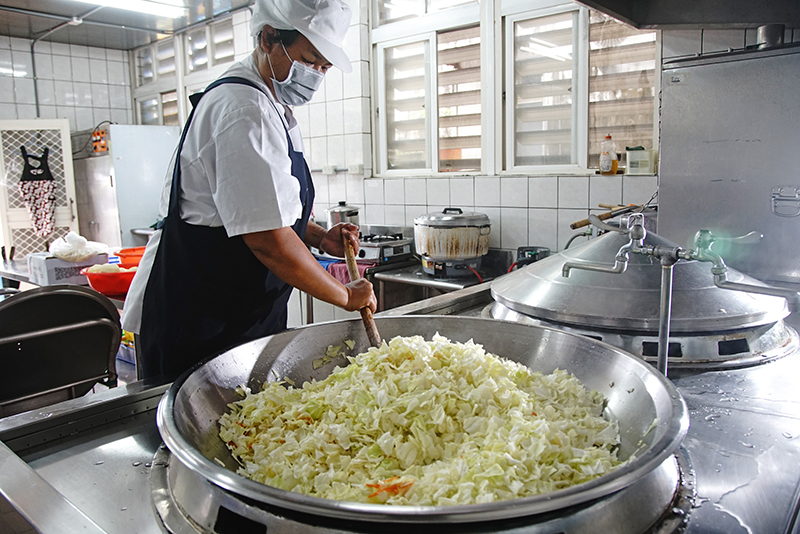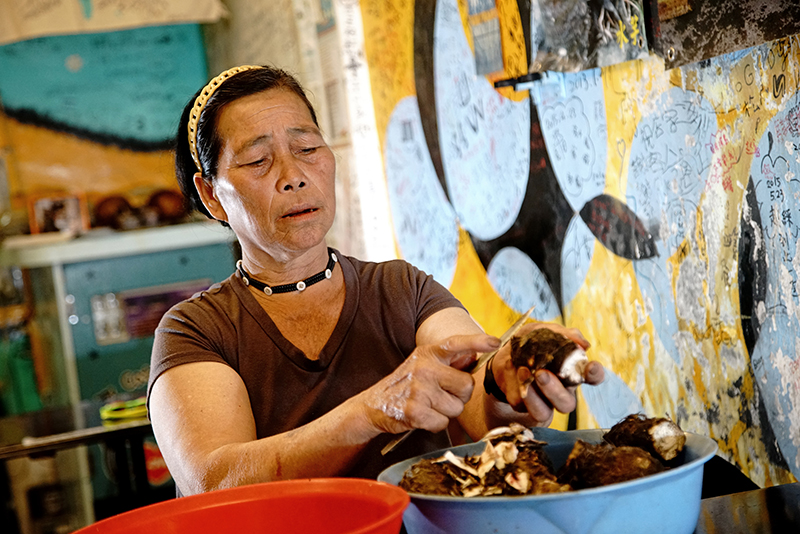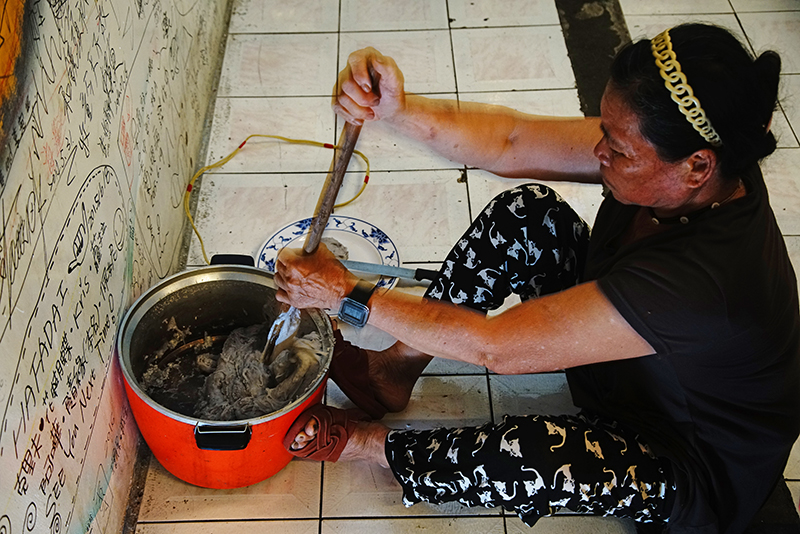Above: In Lanyu, taro fields used to spread all over hills and plains across the island, but now most of them have been left abandoned due to a shortage of manpower. Today, since young people are not interested in farming, it is common to see that taro fields are tended by a single female elder, who takes up all the farm work from planting to harvesting on her own.
At noon, as the bell rang at Lanyu's Yayu Elementary School, the schoolchildren walked out of classrooms one after another and lined up in the hallway for the school lunch. On the cart were fried rice, scrambled eggs, stirred-fried bok choy, and radish soup. But there were no fish and taro, the traditional staple foods of the Tao people native to the island.
For all the four primary schools on the island, ingredients for the school lunch are prepared by the central kitchen in downtown Taitung and delivered by ships twice a week. At lunchtime, we went to the first-grade classroom to do a simple survey, inquiring all the fifteen pupils whether they had ever had taro.
Everyone nodded their heads, replying that their moms or grandmas would cook it at home. Apparently, taro as a staple food was no foreign to them. But when asked to choose between fried rice and taro, they appeared not so consistent in their responses.
Some of them replied shyly after a long thought, saying "Either will do;" some answered "fried rice" immediately, while still others claimed that French fries were what they liked best. During this constant exchange of ideas and comments, however, no such answer as "I like taro" was heard. This reminded us of a scene from the movie Long Time no Sea, where an angry Tao boy complains to his grandma, "Why do you always want me to eat taro while everyone else can have pork ribs rice?"

To promote healthy eating and prevent obesity in children, a nutritional lunch program is launched in primary and secondary schools across Taiwan, featuring a nearly identical menu nationwide. This has resulted in school children in Indigenous communities gradually losing connection with their roots and knowledge of their own cultures in terms of diet.

Having worked with Yayu Elementary School for years, the kitchen worker rarely sees local ingredients used for lunch.
An Indispensable Offering
for Traditional Rituals
“When I was a child, every time I got hungry from playing in the sea, I would go home to find something to eat. Grandma then would feed us with taro wrapped in the giant taro leaves, which was the best snack I have ever had,” recalls Yiyukusyaw suning, director of Educational & Student Affairs Division of Yayu Elementary School, who is a native of Lanyu. Taro has played an indispensable part of his childhood memories. He told us that the Tao people prefer a simple way of cooking without excessive seasoning so that the original flavor of ingredients can be preserved. Take taro for example. The steamed taro served with soy sauce, along with alibangbang (flying fish), would simply make for an authentic delicacy.
Traditionally, the economy of the Tao people is principally based on fishing and farming, with men going out to fish and women taking care of the fields. In the past, every household had its own taro fields. The Tao women bending over to work in fields under the scorching sun was a common scene throughout the island. They did not apply fertilizers and pesticides, but simply used such aquatic plants as floating ferns or duckweed as a source of nutrients and relied on birds and frogs that feed on insects to protect taros from pests. In the Tao language, there are seven different names for taros depending on their growing environments and uses. This fully demonstrates the significant role that taro has played in the Tao's cuisine culture and how much emphasis is placed on it.
“As I remember, when a ritual was to be held to celebrate the completion of a new Tatala boat, stack upon stack of taro plants would be placed inside and around the boat as offerings. That scene was what impressed me most when I was a child,”recalls Yiyukusyaw suning. In Lanyu, it is a local custom to hold a ceremony when a new large boat is to be launched during the alibangbang season. To match the growth cycle of taro, people have to start planting it the year before, and even relatives are called upon to assist. A few days before the launching ceremony, women in the village would dress themselves up in traditional attire and go on to harvest taros from fields as offerings.
In Lanyu, clan members are strongly bonded with each other. After a ritual, the host would give guests “gift taro” and “gift pork” as souvenirs, and upon the completion of a new house, plenty of taros would be prepared as gifts as well. Taro, apart from being a common food on the dining table, serves as a representation of joy on such ceremonial occasions as mentioned above.



In the past, the Tao women would make nimay as a special treat for their husbands to replenish their energy after returning from fishing. However, as the process is too laborious, today few young people are willing to take the time and effort to make this traditional dish. Across the island, only a few seniors remain who still knows how to make nimay.
A Culinary Culture
with a Clear Division of Labor
Apart from taro, alibangbang is another important ingredient in the Tao people's cuisine. Every spring, when alibangbang migrate to the waters of Lanyu, the six villages around the island will hold Mivanwa (fish-beckoning ceremony) in turns to pray for a good harvest, which usually takes place in mid- or late March. Yiyukusyaw suning tells us that the way people deal with alibangbang varies from village to village, with some giving three cuts on each side and one on the bottom, or four on each side and two on the bottom. But no matter which approach is adopted, it is always men who are to give cuts and women to handle the innards, and cooking is then left to men.
While men go out to sea to fish, women staying at home are far from sitting idle. To appreciate the hard work of their men, women often have to get up early in the middle of the night to peel taro to make nimay (taro cake), the traditional delicacy offered as a special treat only on mirayon (Alibangbang season) and minganangana (crab season).
“If your taro fields are not well-tended, no one would dare to marry you,”says Lee Feng-Ying, an elder from the village who tells us how committed the early Tao women are in tending their taro fields as she peels taros deftly with a knife. Although making nimay requires much time and effort, it is a way for the Tao women to show their love and gratitude for the loved ones. To make the dish, first of all, you have to boil taro in a pot; then mash the boiled taro with a wooden pestle until it turns sticky. Finally, flavor the taro cake with a little salt and melted lard from pork skin smoked by burning reeds. The dish is served with crabs and smoked pork skin, featuring a solid mouthfeel with a delicate fragrance of taro and rich aroma of lard. This is undoubtedly the most magnificent comfort food for exhausted family members after a good day of hard work.
“It used to be that every Tao woman tended to make nimay themselves, except for lazy ones. But now things have changed...,” laments Lee. Nowadays, young people prefer buying taro directly from Taiwan proper and use a blender instead of their own hands. The scene that Tao women sat on the ground mashing the boiled taro with a wooden pestle using the whole body strength has gradually become a little-known piece of oral history from village elders.

The Tao culture has a deep connection with Christianity. Children are taught to say grace before meals to thank God for the food.
Revitalizing Culinary Traditions
through School-Community Collaboration
“How will we be able to revive our own culinary culture if taro fields are being replaced by cement buildings?” says Yiyukusyaw suning worriedly. The reality we are faced with, however, is that our children are eating school lunch centrally prepared by the government and are fond of seeking new and surprising snacks in convenience stores after school. The traditional Tao culinary culture featuring taro as a staple food seems to have vanished into the memories of the older generation. Although traditional cuisine is still valued at homes and communities, at school children are fed with rice or noodles every day. Their eating habits have been assimilated into those of Non-indigenous people, like the now-ubiquitous abandoned taro fields turning desolate over time.
Today the number of taro fields being farmed on the island has been shrinking. This is partly due to the invasion of the dominant rice culture, which causes a decline in the demand for taro. On the other hand, the massive outflow of the youth has led to villagers giving up on farming as the main means of livelihood. Few and fewer households are dedicated to growing taro. The scene that every household has its own taro field has been difficult to see.
To familiarize the younger generation with their own culture, every year on Mother's Day, Yayu Elementary School makes it a routine to organize a flying-fish cutting experience activity for its pupils under the instruction of village elders. The purpose is to offer children from non-fishing families an opportunity to learn about the Tao's distinctive alibangbang culture. Apart from this, Yiyukusyaw suning also proposes that the school designate a day every five weeks to offer lunch made with traditional ingredients to foster students' ethnic identity via food education. The authorities can play a leading role by adopting local taro fields or signing contracts with local farmers for sustained provision of taro. Besides, restaurant operators suggest making changes to traditional foods by applying modern ways of cooking to cater to children's preferences. Take nimay for example, it can be transformed into small taro cakes deep-fried with a sugar coating. As children become more receptive to traditional foods, they will naturally grow less addicted to fast food.
Only when taro and alibangbang appear on the dining table frequently will the traditional Tao culinary culture be able to be sustained. Just as the Tao boy in Long Time no Sea, who keeps asking for pork rib rice most of the time, should turn to his grandma for taro when he feels most vulnerable, taro and alibangbang indeed not only serve as traditional ingredients but also the carrier of warm memories shared by close family members.




